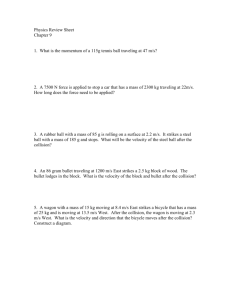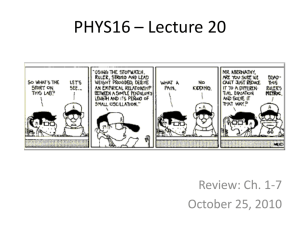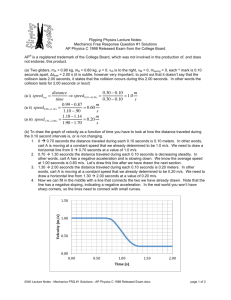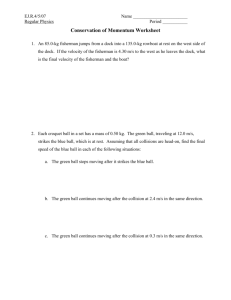February 29, 2008 PHY2053 Discussion Quiz 6 (Chapter 6.1 -6.3)
advertisement
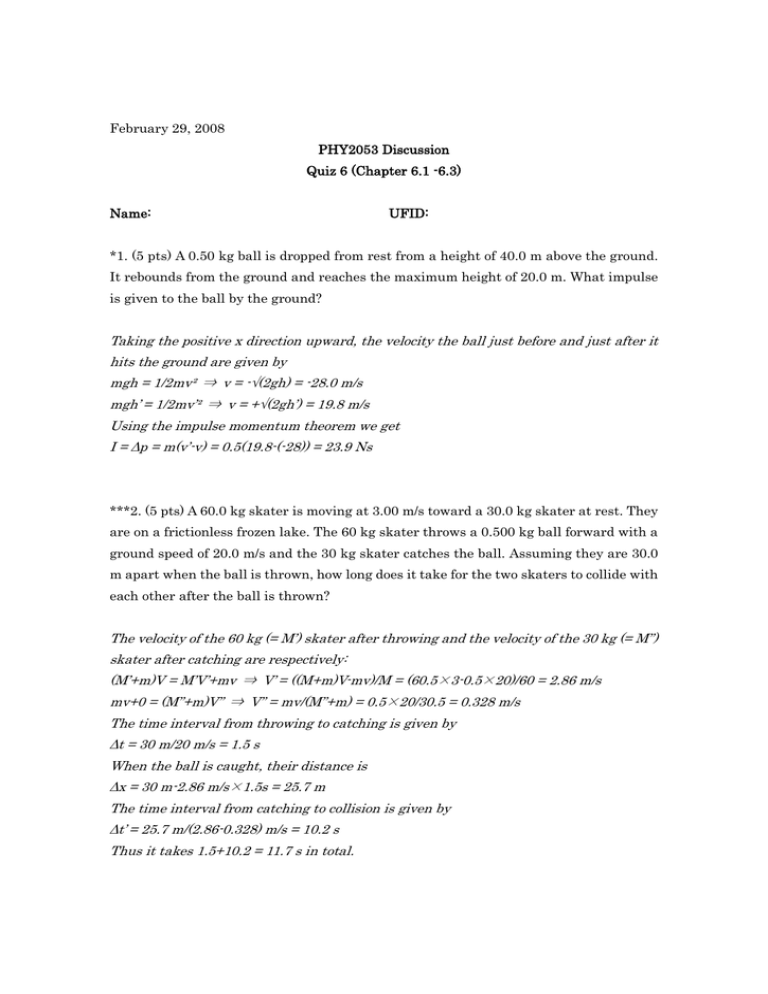
February 29, 2008 PHY2053 Discussion Quiz 6 (Chapter 6.1 -6.3) Name: UFID: *1. (5 pts) A 0.50 kg ball is dropped from rest from a height of 40.0 m above the ground. It rebounds from the ground and reaches the maximum height of 20.0 m. What impulse is given to the ball by the ground? Taking the positive x direction upward, the velocity the ball just before and just after it hits the ground are given by mgh = 1/2mv² ⇒ v = -√(2gh) = -28.0 m/s mgh’ = 1/2mv’² ⇒ v = +√(2gh’) = 19.8 m/s Using the impulse momentum theorem we get I = Δp = m(v’-v) = 0.5(19.8-(-28)) = 23.9 Ns ***2. (5 pts) A 60.0 kg skater is moving at 3.00 m/s toward a 30.0 kg skater at rest. They are on a frictionless frozen lake. The 60 kg skater throws a 0.500 kg ball forward with a ground speed of 20.0 m/s and the 30 kg skater catches the ball. Assuming they are 30.0 m apart when the ball is thrown, how long does it take for the two skaters to collide with each other after the ball is thrown? The velocity of the 60 kg (= M’) skater after throwing and the velocity of the 30 kg (= M”) skater after catching are respectively: (M’+m)V = M’V’+mv ⇒ V’ = ((M+m)V-mv)/M = (60.5×3-0.5×20)/60 = 2.86 m/s mv+0 = (M”+m)V” ⇒ V” = mv/(M”+m) = 0.5×20/30.5 = 0.328 m/s The time interval from throwing to catching is given by Δt = 30 m/20 m/s = 1.5 s When the ball is caught, their distance is Δx = 30 m-2.86 m/s×1.5s = 25.7 m The time interval from catching to collision is given by Δt’ = 25.7 m/(2.86-0.328) m/s = 10.2 s Thus it takes 1.5+10.2 = 11.7 s in total. **3. (5 pts) A 2.00 kg block slides down an inclined frictionless track, starting from rest from a height of 5.00 m above the bottom of the track. At the bottom of the track, it makes a head-on elastic collision with 10.0 kg block which is at rest before the collision. To what maximum height does the 2 kg block bounce back after the collision? Since the mechanical energy of the 2 kg block is conserved before the collision, we have mgh = (1/2)mv² ⇒ v = √(2gh) = 9.90 m/s During the collision, the total momentum of the system is conserved. Also the relative speed is conserved because the collision is elastic. Thus we have mv= mv’+MV’ & v = V’-v’ ⇒ V’ = v+v’ Substituting the expression for V’ into the first equation, we solve it for v’: mv = mv’+M(v+v’) ⇒ v’ = (m-M)v/(m+M) = (2-10)×9.9/(2+10) = 6.60 m/s The mechanical energy is conserved after the collision, thus mgh’ = (1/2)mv’² ⇒ h’ = v’²/(2g) = 6.6²/(2×9.8) = 2.22 m *4. (5 pts) Three carts of masses 4.00 kg, 8.00 kg and 6.00 kg are on a frictionless horizontal track. The 8 kg cart is initially at rest, the 4 kg cart moves at 4.00 m/s toward the 8 kg cart, and the 6 kg cart moves toward the 8 kg cart with a velocity of 6.00 m/s in the opposite direction of the 4 kg cart. Assuming they make perfectly inelastic collisions, find the final common velocity of the three carts. Regardless the order of collisions, all three carts stick together in the end. Applying the momentum conservation from the initial state and the final state, we have mv+m’v’+m”v” = (m+m’+m”)V ⇒ V = (mv+m’v’+m”v”)/ (m+m’+m”) = (4×4+6×(-6)+8×0)/(4+6+8) = -1.11 m/s ⇒ 1.11 m/s in the same direction as the initial 6 kg cart motion

